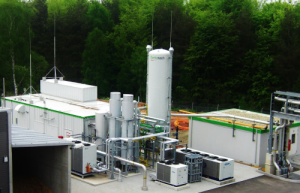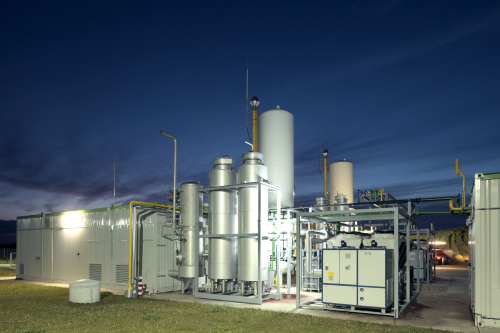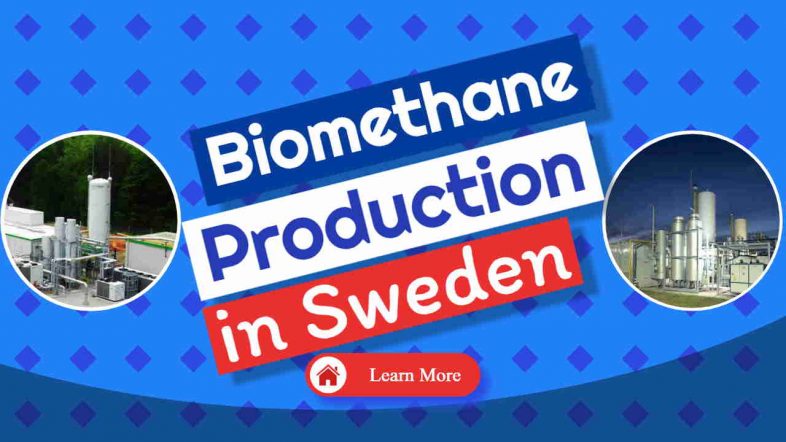Biomethane Production in Sweden continues to lead in installed biomethane facilities just as it did when we first reported this in 2014. We said at the time that “Sweden’s leading role in bioenergy through biomethane production, with the world's largest installed biogas upgrading capacity, is set to further pull ahead”.
It did and now in 2022, they have moved on to the point where by 2030 they aim to supply even more biomethane as a major contributor to the nation's gas grid consumption.
Our first article is still reproduced below. Although it was published 10 years ago in August 2014 it still remains topical.

A lot has changed since then, and biomethane production has risen greatly. Carbotech has built biomethane plants in many nations, including in France, as reported below.
So, we thought that we would add more general information on biomethane production to start, in the introduction which follows.
We hope this will explain why Sweden was right to go for biomethane back in 2014.
Biomethane Production in Sweden
Sweden is a world leader in biogas production. They have an extensive infrastructure for biogas production, including an extensive network of biogas plants, which makes it easier than anywhere else to buy biogas.
Sweden also has a strong focus on sustainability, which means that they are committed to using biogas as a sustainable energy source.
The Swedish anaerobic digestion industry has now moved on from just making the biogas. It is upgrading (purifying) the raw output from the digester tanks and producing biomethane.
Biomethane has the advantage over biogas because it can be used in many more ways. Biomethane can be used as a fuel to power cars, heat homes, and factories, and can also be processed into plastics, and other products.
Not only that, biomethane can be pressurised and injected into the gas grid. This means that biomethane can be used as a replacement for natural gas, with the same applications in the gas grid.
The Biomethane Market in Sweden
This new and rapidly growing market is estimated to generate revenues of around 9 billion Carbotech Gas Systems GmbH in 2020. Biomethane production in Sweden will grow rapidly in the next 10 years.
Sweden is estimated to produce over 2 billion cubic metres of biomethane by the end of the decade. This growth is fuelled by:
- national policy to reduce the nation's dependence on fossil fuels and join with all nations to reduce climate change by reducing carbon emissions
- by the country's estimated population of around 9.5 million people, which is expected to increase by around 500,000 in the next ten years
- the Russian war with Ukraine and the resulting extremely high natural gas prices
- the need to produce their own energy to improve the nation's security of supply.
The increased demand for biomethane is resulting in increased investment in the sector, which in turn will lead to an increase in the production of this clean energy resource.
Biomethane is a clean-burning, renewable energy source that is made from organic matter such as food waste, plant waste, and even sewage. By generating biomethane, the Swedish anaerobic digestion industry is helping to reduce greenhouse gas emissions and improve air quality.
Biomethane Production Basics
Biomethane can be produced either by anaerobic digestion or by gasification of organic matter. Organic matter fed into the biomethane plant is transformed by an anaerobic process into biomethane i.e. a compound of methane (CH4) and carbon dioxide.
As of 2016, Biomethane production from biogas was the single largest source, globally. Biogas is upgraded by various gas treatment processes to produce biomethane.
During this upgrading process, contaminants are either absorbed or scrubbed from the gas to obtain more methane per unit volume of the residual gas.
Gasification converts organic matter into syngas, which is then processed to produce methane. Methane as a whole is about 20 times more potent GHG (Greenhouse Gas) than CO2 if released into the atmosphere.
When used in power generation, it generates heat and emits carbon dioxide and some other gases.
Despite many shortcomings, biomethane produced from organic matter eliminates the release of a great deal of methane and other harmful gases into the atmosphere. The production of biomethane eliminates exposure of decaying organic matter to the air. This avoids methane and other harmful gases from entering the atmosphere. via Transparency Market Research
Biomethane is a naturally occurring gas produced by anaerobic digestion of organic matter like plant and animal wastes, manure, sewage sludge, and other organic matter. Thus it has emerged as a renewable source of energy and is now produced worldwide.
“Pipeline Quality Gas”
Biomethane or Renewable natural gas (RNG) is a pipeline-quality gas which is interchangeable with conventional gas. It can be used as a 100% substitute for conventional gas streams for use in automobiles. It can also be blended with natural gas.

Climate Change Reduction
The developed nations of the world are diversifying their energy demand with more renewable sources. At the Climate Change Conference COP26 held in Glasgow in 2021, biogas production was one of the technologies that many nations agreed to develop to raise their renewable energy output.
The key factor driving the growth of the global biomethane market is the negative impact of conventional fuels on the environment such as harmful carbon emissions and global warming.
Such negative impacts and the continuous depletion of fossil reserves have led to an increase in the usage of biomethane as an energy source. As per the research done by California Energy Commission, biomethane can reduce GHG emissions by up to 87% compared to conventional petroleum-based fuels.
The Global Biomethane Market
The adoption of biomethane as an alternative fuel, along with the above-mentioned factors is driving the global biomethane market. Whereas, the requirement to meet the gas quality standards in international trade, low power output for industries, and high investment costs act as the major hurdles in the growth of the market.
However, surging environmental concerns along with increasing government initiatives are expected to create huge opportunities for the growth of the market in the coming years. via Biomethane Market Size, Share, Growth & Forecast By 2025.
(Archived Article) – Now find out about Schmack Biogas' Plant Expansion:
Schmack Biogas to build a second biomethane production plant in France
Follow-on project opens up new market opportunities
Schwandorf, March 6th, 2017. Schmack Biogas, a Viessmann Group company, has been awarded a further contract for the construction of a biomethane production plant in Sourdun in northern France.
In mid-December, the French government adopted a new feed-in tariff for electricity from biogas. France is the biggest country in the EU and uses a much larger area for agriculture than Germany. The potential for biogas plants is enormous. With this new regulation, and in particular the subsidy, which is being extended by up to five years, it is highly likely that market growth will be stronger in future.
The planned biogas plant is expected to be able to produce 250 Nm³/h of raw biogas in the first phase of its development. However, the design already includes a possible second development phase to increase production to 500 Nm3/h of raw biogas. The raw biogas will be refined to a methane content of at least 97% by means of pressure swing adsorption (PSA process). As a result, the biogas will be of natural gas quality and will be able to be fed into Sourdun's local supply network.
Schmack Carbotech, the Viessmann Group's biogas upgrading specialist, will supply the gas upgrading plant. Schmack Biogas will supply the biogas plant and is responsible for the entire project in its role as the general contractor. via Second biomethane plant in France
Biomethane Production Facts
As of 2016, biomethane production from biogas was the single largest source, globally.
Biogas is upgraded by various gas treatment processes to produce biomethane.
Biomethane can be produced either by anaerobic digestion or by gasification of organic matter.
Biomethane from Anaerobic Digestion/ Biogas
Organic matter fed into the biogas plant is transformed by the anaerobic process into biogas (i.e. a compound of methane (CH4) and carbon dioxide).
During this upgrading process, contaminants are either absorbed or scrubbed from the gas to obtain more methane per unit volume of the residual gas.
Biomethane from Syngas
Gasification converts organic matter into syngas, which is then processed to produce methane.
Greenhouse Gas Potency
Methane as a whole is about 20 times more potent GHG (Greenhouse Gas) than CO2 if released into the atmosphere.
When used in power generation, it generates heat and emits carbon dioxide and some other gases.
Despite all these shortcomings, biomethane produced from organic matter eliminates the release of a great deal of methane and other harmful gases into the atmosphere.
The production of biomethane eliminates exposure of decaying organic matter to the air. This avoids methane and other harmful gases from fleeing into the atmosphere. via Transparency Market Research
The Original 2014 Article:
Sweden's Lead in Biomethane Production Continues With Major New Schmack Carbotech Plant
Schmack Carbotech Stockholm: Sweden’s leading role in bioenergy through biomethane production, with the world's largest installed biogas upgrading capacity, is set to further pull ahead. It is going beyond the level of all other nations with the announcement that Schmack Carbotech has been signed-up as the design and build contractor for a 2,000 Nm³/h biogas processing facility. The facility will be located to the south of Stockholm.
Schmack Carbotech is using its innovative Pressure Swing Adsorption (PSA) technology in its biomethane production. It will be used in a development that will enable the Swedish capital to produce pure methane (biomethane) from more biogas.
This will increase the proportion of biomethane it uses by 50%. This will provide biofuel for vehicles currently powered by natural gas. The biomethane production will be of a high purity gas leaving the PSA with a methane content in excess of 97 per cent.

The plant will be fed by organic waste and waste kitchen oil.
It will be located in Sofielund, Huddinge, and will produce biogas with an annual energy yield of nearly 100 million kilowatt hours. That's enough to supply approximately 5,000 vehicles clocking up an average of 20,000 km per year each.
Part of the Viessmann Group, Schmack Carbotech’s Pressure Swing Adsorption (PSA) principle distinguishes itself from other technologies.
It does this because of its favourably low energy consumption, efficient heat extraction and high methane yield.
The company’s International Business Manager, Eberhart Wusterhaus Gomez, explained:
“This important new biomethane production contract at Sofielund brings to bear all of our 30 years ‘experience in the development, engineering and manufacturing of turnkey gas upgrading plants.
“As industry pioneers and market leaders in biogas purification, we are very keen to play our part in delivering a low energy yet high yield technology. A technology that in this case fits in perfectly with the Swedish government’s long-term thinking. Their aim is to become the world’s first completely oil-free economy”.
Setting new standards in biogas process efficiency, Sofielund’s new plant will be equipped with:
- a CNG station,
- a Carbotech PSA plant,
- off-gas cleaning with
- high heat recovery system combined with
- a peak load boiler.
The biomethane production plant will also benefit from ultra-reliable VOC and Hydrogen Sulphide removal. This will make Carbotech’s robust technology ideal to produce biomethane from biogas, sewage gas and landfill gas for:
- grid injection and
- CNG vehicle fuel.

As well as being a specialist in upgrading biogas plants, the Viessmann Group is actively implementing complete biogas turnkey solutions worldwide.
Installations include award-winning biological technology, with
- special wet fermentation (from Schmack Biogas) and
- batch-dry fermentation (BioFerm technology).
BioFerm technology is now integral to parts of more than 300 cogeneration and biomethane plants in Europe and beyond.
This includes Europe’s largest dry-AD-from-organic-waste plant, located in Fife, Scotland.
The Viessmann Group is a leading international manufacturer of heating technology systems.
Founded in 1917, the family company has around 11,400 employees with group sales of EUR 2.1 billion.
Viessmann has an international presence with 27 production companies in 11 countries, sales companies and representations in 74 countries and 120 sales branches worldwide. 55% of sales are generated abroad.






These are actually ideas to follow up on regarding biogas. You have made a good point here. But, is Schmack part of Viessmann now? Therefore, is it actually Swedish, or German. If this is German technology the lead is German not Swedish, I say. Any way keep up writing.
Sweden is a very good progressive nation. They are advanced in biogas, or should I say biomethane?
Hi there, i read your blog from time to time and i own a similar one and i was just curious if you get
a lot of spam feedback? If so how do you reduce it? I get so much lately it’s driving me mad.
I use the “Spam Bee” plugin. It is really good at identifying and deleting the spam. You still need to keep an eye out though, because it’s not perfect, and some spam does get through I’m afraid.
Really enjoyed looking through. Biogas to biomethane. That’s how they do it.
I presume there are other technologies to do this, as well? How does the Carbotech equipment rate for up-time, running cost and overall value for money?
I was reading a piece in the news papers on this, so now as I am a user of web I decided to look it up.
Thanks to web I see your writing, but now am puzzled. You say carbon dioxide not bad, but everyone else says it is the greenhouses gas. I know you are not like Trump, but am not knowing what to think.
The crop for the biomass needed has to be sown, fertilized, probably sprayed, plus harvested and then transported from the farm to the plant. That’s an awful lot of diesel fuel: not very green. so Is it really worth it?
Have you heard about NeoZeo? Neozeo provides new biogas upgrading equipment for the production of high value biomethane from raw biogas produced on farms or from municipal waste. They were a winner in the European Business Awards 2017-18. I put their site in the url box for you.
I want to introduced your plant in Jodpur village in India